Not Only Trees Matter—Traffic-Related PM Accumulation by Vegetation of Urban Forests
Abstract
1. Introduction
2. Materials and Methods
2.1. Study Area
2.2. Plant Sample Collection
2.3. Quantitative Analysis of PM in Horizontal and Vertical Vegetation Zones
2.4. Quantitative Analysis of PM in the Air
2.5. Statistical Analysis
2.6. SEM Examinations
3. Results
3.1. Vegetation Species Composition
3.2. PM Concentrations in the Air
3.3. PM Accumulation on Plants
3.4. SEM Examinations
3.5. Semi-Quantitative Analysis
4. Discussion
5. Conclusions
Author Contributions
Funding
Institutional Review Board Statement
Informed Consent Statement
Data Availability Statement
Conflicts of Interest
References
- Haddad, N.M.; Brudvig, L.A.; Clobert, J.; Davies, K.F.; Gonzalez, A.; Holt, R.D.; Lovejoy, T.E.; Sexton, J.O.; Austin, M.P.; Collins, C.D.; et al. Habitat Fragmentation and Its Lasting Impact on Earth’s Ecosystems. Sci. Adv. 2015, 1, e1500052. [Google Scholar] [CrossRef] [PubMed]
- Patarkalashvili, T. Urban Forests and Green Spaces of Tbilisi and Ecological Problems of the City. Ann. Agrar. Sci. 2017, 15, 187–191. [Google Scholar] [CrossRef]
- Referowska-Chodak, E. Pressures and Threats to Nature Related to Human Activities in European Urban and Suburban Forests. Forests 2019, 10, 765. [Google Scholar] [CrossRef]
- Health Effects Institute (HEI). Traffic-Related Air Pollution: A Critical Review of the Literature on Emissions, Exposure, and Health Effects; HEI: Boston, MA, USA, 2010; pp. 5–44. [Google Scholar]
- World Health Organization (WHO). Review of Evidence on Health Aspects of Air Pollution-REVIHAAP Project; WHO Regional Office for Europe: Bonn, Germany, 2013; pp. 12–126. [Google Scholar]
- Tong, Z.; Baldauf, R.W.; Isakov, V.; Deshmukh, P.; Max Zhang, K. Roadside Vegetation Barrier Designs to Mitigate Near-Road Air Pollution Impacts. Sci. Total Environ. 2016, 541, 920–927. [Google Scholar] [CrossRef]
- Hime, N.J.; Marks, G.B.; Cowie, C.T. A Comparison of the Health Effects of Ambient Particulate Matter Air Pollution from Five Emission Sources. Int. J. Environ. Res. Public Health 2018, 15, 1206. [Google Scholar] [CrossRef]
- Zinia, N.J.; McShane, P. Ecosystem Services Management: An Evaluation of Green Adaptations for Urban Development in Dhaka, Bangladesh. Landsc. Urban Plan. 2018, 173, 23–32. [Google Scholar] [CrossRef]
- Xing, Y.-F.; Xu, Y.-H.; Shi, M.-H.; Lian, Y.-X. The Impact of PM2.5 on the Human Respiratory System. J. Thorac. Dis. 2016, 8, E69–E74. [Google Scholar] [CrossRef]
- European Environment Agency (EEA). The European Environment—State and Outlook 2020: Knowledge for Transition to a Sustainable Europe. Available online: https://www.eea.europa.eu/soer/2020 (accessed on 10 December 2021).
- Pant, P.; Harrison, R.M. Estimation of the Contribution of Road Traffic Emissions to Particulate Matter Concentrations from Field Measurements: A Review. Atmos. Environ. 2013, 77, 78–97. [Google Scholar] [CrossRef]
- Nawrot, N.; Wojciechowska, E.; Rezania, S.; Walkusz-Miotk, J.; Pazdro, K. The Effects of Urban Vehicle Traffic on Heavy Metal Contamination in Road Sweeping Waste and Bottom Sediments of Retention Tanks. Sci. Total Environ. 2020, 749, 141511. [Google Scholar] [CrossRef]
- Dzikuć, M.; Adamczyk, J.; Piwowar, A. Problems Associated with the Emissions Limitations from Road Transport in the Lubuskie Province (Poland). Atmos. Environ. 2017, 160, 1–8. [Google Scholar] [CrossRef]
- Weijers, E.; Khlystov, A.; Kos, G.; Erisman, J. Variability of Particulate Matter Concentrations along Roads and Motorways Determined by a Moving Measurement Unit. Atmos. Environ. 2004, 38, 2993–3002. [Google Scholar] [CrossRef]
- Wang, J.; Chan, T.; Ning, Z.; Leung, C.; Cheung, C.; Hung, W. Roadside Measurement and Prediction of CO and PM2.5 Dispersion from On-Road Vehicles in Hong Kong. Transp. Res. Part D Transp. Environ. 2006, 11, 242–249. [Google Scholar] [CrossRef]
- Zhu, Y.; Hinds, W.C.; Kim, S.; Shen, S.; Sioutas, C. Study of Ultrafine Particles Near a Major Highway with Heavy-Duty Diesel Traffic. Atmos. Environ. 2002, 36, 4323–4335. [Google Scholar] [CrossRef]
- Wu, Y.; Hao, J.; Fu, L.; Wang, Z.; Tang, U. Vertical and Horizontal Profiles of Airborne Particulate Matter Near Major Roads in Macao, China. Atmos. Environ. 2002, 36, 4907–4918. [Google Scholar] [CrossRef]
- Timmers, V.R.; Achten, P.A. Non-Exhaust PM Emissions from Electric Vehicles. Atmos. Environ. 2016, 134, 10–17. [Google Scholar] [CrossRef]
- Thorpe, A.; Harrison, R.M. Sources and Properties of Non-Exhaust Particulate Matter from Road Traffic: A Review. Sci. Total Environ. 2008, 400, 270–282. [Google Scholar] [CrossRef]
- Penkała, M.; Ogrodnik, P.; Rogula-Kozłowska, W. Particulate Matter from the Road Surface Abrasion as a Problem of Non-Exhaust Emission Control. Environments 2018, 5, 9. [Google Scholar] [CrossRef]
- United Nations Environment Programme (UNEP). Annual Report 2011; UNEP Division of Communications and Public Information: Nairobi, Kenya, 2012. [Google Scholar]
- Maes, J.; Domenech, F.N.; Zulian, G.; Lopes Barbosa, A.; Vizcaino Martinez, M.; Polce, C.; Vandecasteele, I.; Mari Rivero, I.; Bastos de Morais Guerra, C.; Perpiña Castillo, C.; et al. Mapping and Assessment of Ecosystems and Their Services: Trends in Ecosystems and Ecosystem Services in the European Union between 2000 and EUR 27143; Publications Office of the European Union: Luxembourg, 2015. [Google Scholar]
- Konijnendijk, C.C. The Forest and the City. In The Cultural Landscape of Urban Woodland; Springer: New York, NY, USA, 2008. [Google Scholar] [CrossRef]
- Zhang, Y.; Chen, H.Y.H.; Reich, P. Forest Productivity Increases with Evenness, Species Richness and Trait Variation: A Global Meta-Analysis. J. Ecol. 2012, 100, 742–749. [Google Scholar] [CrossRef]
- Zhang, F.; Chung, C.K.L.; Yin, Z. Green Infrastructure for China’s New Urbanisation: A Case Study of Greenway Development in Maanshan. Urban Stud. 2019, 57, 508–524. [Google Scholar] [CrossRef]
- Jaszczak, R. Forest and Forest Management within the Influence of Cities in Poland. (Las i Gospodarka Leśna w Zasięgu Oddziaływania Miast w Polsce). Stud. Mater. CEPL 2008, 10, 152–171. (In Polish) [Google Scholar]
- Tyrväinen, L.; Miettinen, A. Property Prices and Urban Forest Amenities. J. Environ. Econ. Manag. 2000, 39, 205–223. [Google Scholar] [CrossRef]
- Fornal-Pieniak, B.; Ollik, M.; Schwerk, A. Impact of Different Levels of Anthropogenic Pressure on the Plant Species Composition in Woodland Sites. Urban For. Urban Green. 2019, 38, 295–304. [Google Scholar] [CrossRef]
- Sanesi, G.; Colangelo, G.; Lafortezza, R.; Calvo, E.; Davies, C. Urban Green Infrastructure and Urban Forests: A Case Study of the Metropolitan Area of Milan. Landsc. Res. 2017, 42, 164–175. [Google Scholar] [CrossRef]
- Ferrini, F.; Fini, A.; Mori, J.; Gori, A. Role of Vegetation as a Mitigating Factor in the Urban Context. Sustainability 2020, 12, 4247. [Google Scholar] [CrossRef]
- Popek, R.; Gawrońska, H.; Wrochna, M.; Gawroński, S.; Saebø, A. Particulate Matter on Foliage of 13 Woody Species: Deposition on Surfaces and Phytostabilisation in Waxes–A 3-Year Study. Int. J. Phytoremediat. 2013, 15, 245–256. [Google Scholar] [CrossRef]
- Mo, L.; Ma, Z.; Xu, Y.; Sun, F.; Lun, X.; Liu, X.; Chen, J.; Yu, X. Assessing the Capacity of Plant Species to Accumulate Particulate Matter in Beijing, China. PLoS ONE 2015, 10, e0140664. [Google Scholar] [CrossRef] [PubMed]
- Chen, B.; Li, S.; Yang, X.; Lu, S.; Wang, B.; Niu, X. Characteristics of Atmospheric PM2.5 in Stands and Non-Forest Cover Sites Across Urban-Rural Areas in Beijing, China. Urban Ecosyst. 2016, 19, 867–883. [Google Scholar] [CrossRef]
- Przybysz, A.; Wińska-Krysiak, M.; Małecka-Przybysz, M.; Stankiewicz-Kosyl, M.; Skwara, M.; Kłos, A.; Kowalczyk, S.; Jarocka, K.; Sikorski, P. Urban Wastelands: On the Frontline between Air Pollution Sources and Residential Areas. Sci. Total Environ. 2020, 721, 137695. [Google Scholar] [CrossRef]
- Zhou, C.; Li, S.; Wang, S. Examining the Impacts of Urban Form on Air Pollution in Developing Countries: A Case Study of China’s Megacities. Int. J. Environ. Res. Public Health 2018, 15, 1565. [Google Scholar] [CrossRef]
- Zhang, X.; Chen, Y. Admissibility and Robust Stabilization of Continuous Linear Singular Fractional Order Systems with the Fractional Order α: The 0 < α < 1 Case. ISA Trans. 2018, 82, 42–50. [Google Scholar] [CrossRef]
- Todorov, V.; Dimov, I.; Ostromsky, T.; Zlatev, Z.; Georgieva, R.; Poryazov, S. Optimized Quasi-Monte Carlo methods based on Van der Corput sequence for sensitivity analysis in air pollution modelling. In Recent Advances in Computational Optimization, WCO 2020, Studies in Computational Intelligence, 1st ed.; Fidanova, S., Ed.; Springer: New York, NY, USA, 2022; Volume 986, pp. 389–405. [Google Scholar] [CrossRef]
- Główny Inspektorat Ochrony Środowiska (GIOŚ). The Condition of the Environment in Poland. Rapport 2018. (Stan Środowiska w Polsce. Raport 2018); Biblioteka Monitoringu Środowiska: Warszawa, Poland, 2018; p. 251. (In Polish) [Google Scholar]
- Matuszkiewcz, W. Guide to the Identification of Plant Communities in Poland (Przewodnik do Oznaczania Zbiorowisk Roślinnych Polski); PWN: Warszawa, Poland, 2014; p. 540. (In Polish) [Google Scholar]
- Public Road Authority (PRA). Interactive Map of the Apr Zdm Automatic Measurement System. Available online: https://zdm-warszawa.maps.arcgis.com (accessed on 18 December 2021).
- Mirek, Z.; Zając, M.; Zając, A.; Piękoś-Mirkowa, H. Vascular Plants of Poland. A Checklist; W. Szafer Institute of Botany: Cracow, Poland, 1995; p. 308. [Google Scholar]
- Braun-Blanquet, J. Parc National Suisse, Zernez et Bernina. Bull. Société Bot. Fr. 1951, 98, 54–58. [Google Scholar] [CrossRef][Green Version]
- Dzierżanowski, K.; Popek, R.; Gawrońska, H.; Saebø, A.; Gawroński, S. Deposition of Particulate Matter of Different Size Fractions on Leaf Surfaces and in Waxes of Urban Forest Species. Int. J. Phytoremediat. 2011, 13, 1037–1046. [Google Scholar] [CrossRef] [PubMed]
- Todorov, V.; Dimov, I.; Ostromsky, T.; Apostolov, S.; Georgieva, R.; Dimitrov, Y.; Zlatev, Z. Advanced Stochastic Approaches for Sobol’ Sensitivity Indices Evaluation. Neural Comput. Appl. 2020, 33, 1999–2014. [Google Scholar] [CrossRef]
- Łukowski, A.; Popek, R.; Karolewski, P. Particulate Matter on Foliage of Betula Pendula, Quercus Robur, and Tilia Cordata: Deposition and Ecophysiology. Environ. Sci. Pollut. Res. 2020, 27, 10296–10307. [Google Scholar] [CrossRef] [PubMed]
- Sgrigna, G.; Baldacchini, C.; Dreveck, S.; Cheng, Z.; Calfapietra, C. Relationships between Air Particulate Matter Capture Efficiency and Leaf Traits in Twelve Tree Species from an Italian Urban-Industrial Environment. Sci. Total Environ. 2020, 718, 137310. [Google Scholar] [CrossRef] [PubMed]
- Li, X.; Zhang, T.; Sun, F.; Song, X.; Zhang, Y.; Huang, F.; Yuan, C.; Yu, H.; Zhang, G.; Qi, F.; et al. The Relationship between Particulate Matter Retention Capacity and Leaf Surface Micromorphology of Ten Tree Species in Hangzhou, China. Sci. Total Environ. 2021, 771, 144812. [Google Scholar] [CrossRef]
- Wang, X.; Teng, M.; Huang, C.; Zhou, Z.; Chen, X.; Xiang, Y. Canopy Density Effects on Particulate Matter Attenuation Coefficients in Street Canyons during Summer in the Wuhan Metropolitan Area. Atmos. Environ. 2020, 240, 117739. [Google Scholar] [CrossRef]
- Patra, A.; Colville, R.; Arnold, S.; Bowen, E.; Shallcross, D.E.; Martin, D.; Price, C.S.; Tate, J.; ApSimon, H.; Robins, A. On street observations of particulate matter movement and dispersion due to traffic on an urban road. Atmos. Environ. 2008, 42, 3911–3926. [Google Scholar] [CrossRef]
- Tong, Z.; Whitlow, T.H.; MacRae, P.F.; Landers, A.J.; Harada, Y. Quantifying the Effect of Vegetation on Near-Road Air Quality Using Brief Campaigns. Environ. Pollut. 2015, 201, 141–149. [Google Scholar] [CrossRef]
- Viippola, V.; Yli-Pelkonen, V.; Järvi, L.; Kulmala, M.; Setälä, H. Effects of Forests on Particle Number Concentrations in Near-Road Environments across Three Geographic Regions. Environ. Pollut. 2020, 266, 115294. [Google Scholar] [CrossRef]
- Przybysz, A.; Popek, R.; Stankiewicz-Kosyl, M.; Zhu, C.; Małecka-Przybysz, M.; Maulidyawati, T.; Mikowska, K.; Deluga, D.; Griżuk, K.; Sokalski-Wieczorek, J.; et al. Where Trees Cannot Grow–Particulate Matter Accumulation by Urban Meadows. Sci. Total Environ. 2021, 785, 147310. [Google Scholar] [CrossRef] [PubMed]
- Eziz, A.; Yan, Z.; Tian, D.; Han, W.; Tang, Z.; Fang, J. Drought Effect on Plant Biomass Allocation: A Meta-Analysis. Ecol. Evol. 2017, 7, 11002–11010. [Google Scholar] [CrossRef] [PubMed]
- Mori, J.; Hanslin, H.M.; Burchi, G.; Sæbø, A. Particulate Matter and Element Accumulation on Coniferous Trees at Different Distances from a Highway. Urban For. Urban Green. 2015, 14, 170–177. [Google Scholar] [CrossRef]
- Popek, R.; Gawrońska, H.; Gawroński, S.W. The Level of Particulate Matter on Foliage Depends on the Distance from the Source of Emission. Int. J. Phytoremediat. 2015, 17, 1262–1268. [Google Scholar] [CrossRef] [PubMed]
- Weber, F.; Kowarik, I.; Säumel, I. Herbaceous Plants as Filters: Immobilization of Particulates along Urban Street Corridors. Environ. Pollut. 2014, 186, 234–240. [Google Scholar] [CrossRef] [PubMed]
- Muhammad, S.; Wuyts, K.; Samson, R. Immobilized Atmospheric Particulate Matter on Leaves of 96 Urban Plant Species. Environ. Sci. Pollut. Res. 2020, 27, 36920–36938. [Google Scholar] [CrossRef]
- Speak, A.F.; Rothwell, J.J.; Lindley, S.J.; Smith, C.L. Urban Particulate Pollution Reduction by Four Species of Green Roof Vegetation in a UK City. Atmos. Environ. 2012, 61, 283–293. [Google Scholar] [CrossRef]
- Janhäll, S. Review on Urban Vegetation and Particle Air Pollution—Deposition and Dispersion. Atmos. Environ. 2015, 105, 130–137. [Google Scholar] [CrossRef]
- Nguyen, T.; Yu, X.; Zhang, Z.; Liu, M.; Liu, X. Relationship between Types of Urban Forest and PM2.5 Capture at Three Growth Stages of Leaves. J. Environ. Sci. 2015, 27, 33–41. [Google Scholar] [CrossRef]
- Zhang, Z.; Liu, J.; Wu, Y.; Yan, G.; Zhu, L.; Yu, X. Multi-Scale Comparison of the Fine Particle Removal Capacity of Urban Forests and Wetlands. Sci. Rep. 2017, 7, srep46214. [Google Scholar] [CrossRef]
- Popek, R.; Haynes, A.; Przybysz, A.; Robinson, S.A. How Much Does Weather Matter? Effects of Rain and Wind on PM Accumulation by Four Species of Australian Native Trees. Atmosphere 2019, 10, 633. [Google Scholar] [CrossRef]
- Xu, X.; Yu, X.; Bao, L.; Desai, A.R. Size Distribution of Particulate Matter in Runoff from Different Leaf Surfaces during Controlled Rainfall Processes. Environ. Pollut. 2019, 255, 113234. [Google Scholar] [CrossRef] [PubMed]
- Bretzel, F.; Vannucchi, F.; Romano, D.; Malorgio, F.; Benvenuti, S.; Pezzarossa, B. Wildflowers: From Conserving Biodiversity to Urban Greening—A Review. Urban For. Urban Green. 2016, 20, 428–436. [Google Scholar] [CrossRef]
- Baldauf, R.; Fortune, C.; Weinstein, J.; Wheeler, M.; Blanchard, F. Air Contaminant Exposures during the Operation of Lawn and Garden Equipment. J. Expo. Sci. Environ. Epidemiol. 2006, 16, 362–370. [Google Scholar] [CrossRef] [PubMed]
- Vos, P.E.J.; Maiheu, B.; Vankerkom, J.; Janssen, S. Improving Local Air Quality in Cities: To Tree or not to Tree? Environ. Pollut. 2013, 183, 113–122. [Google Scholar] [CrossRef]
- Przybysz, A.; Sæbø, A.; Hanslin, H.M.; Gawroński, S. Accumulation of Particulate Matter and Trace Elements on Vegetation as Affected by Pollution Level, Rainfall and the Passage of Time. Sci. Total Environ. 2014, 481, 360–369. [Google Scholar] [CrossRef]
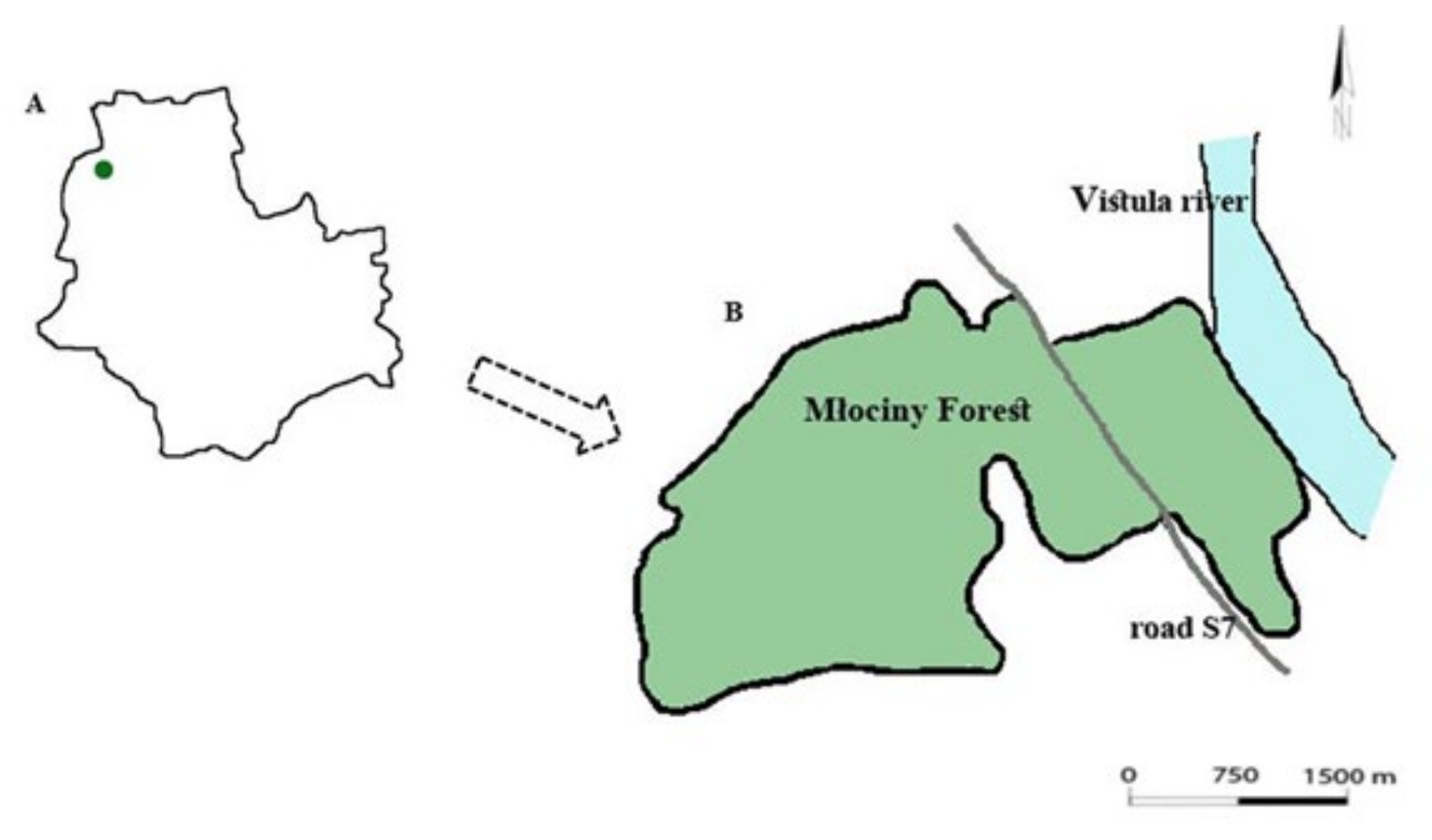
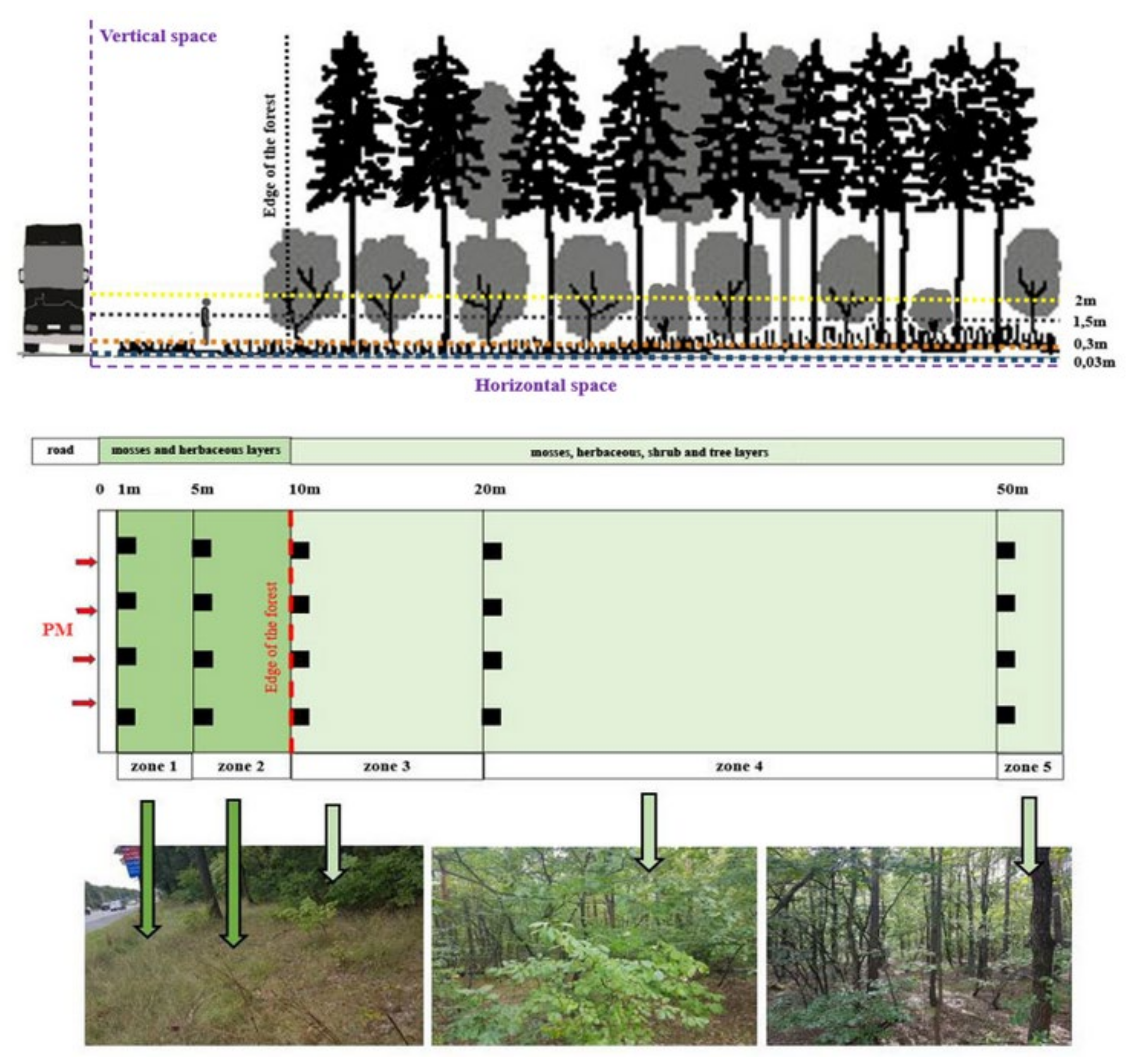
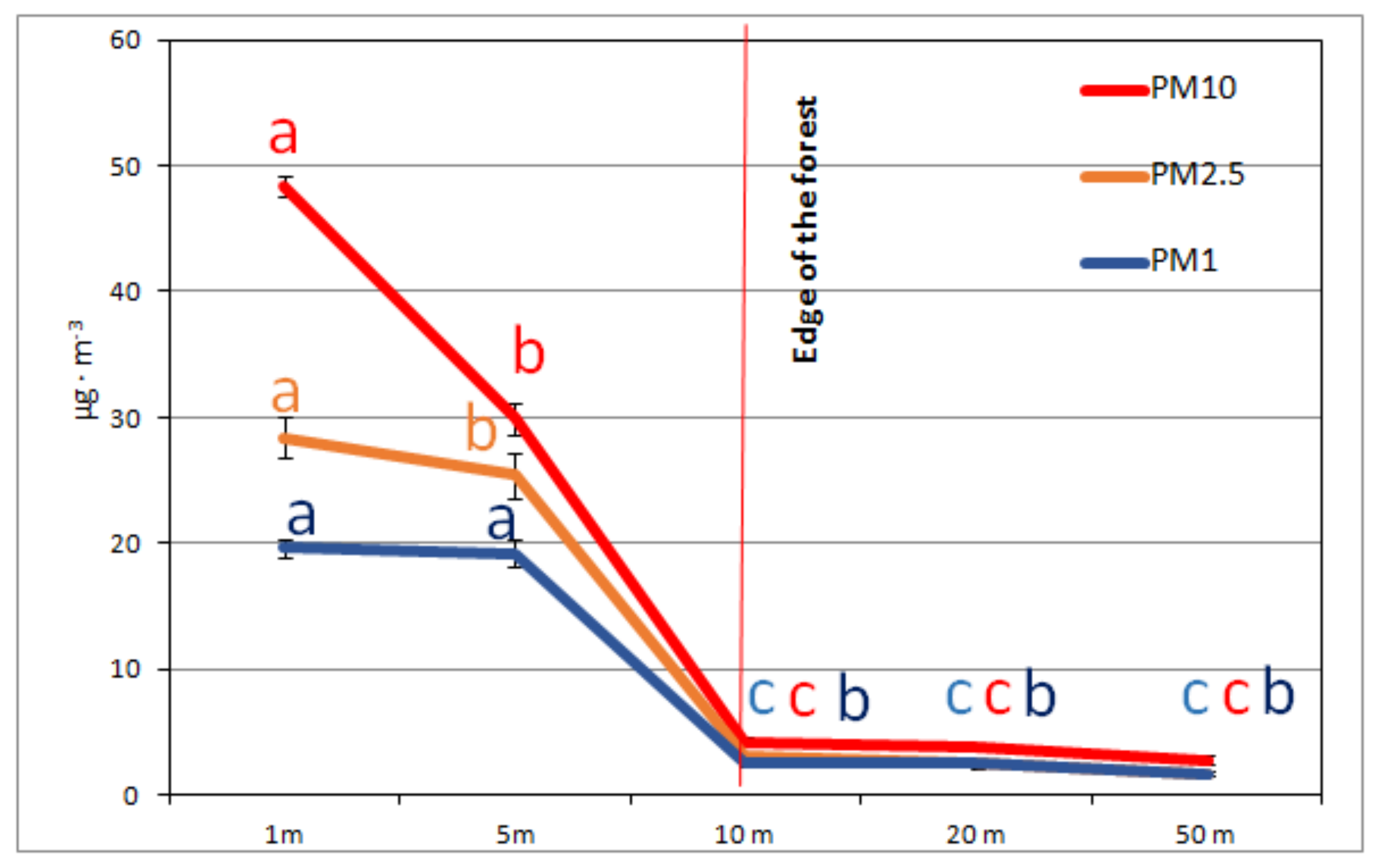
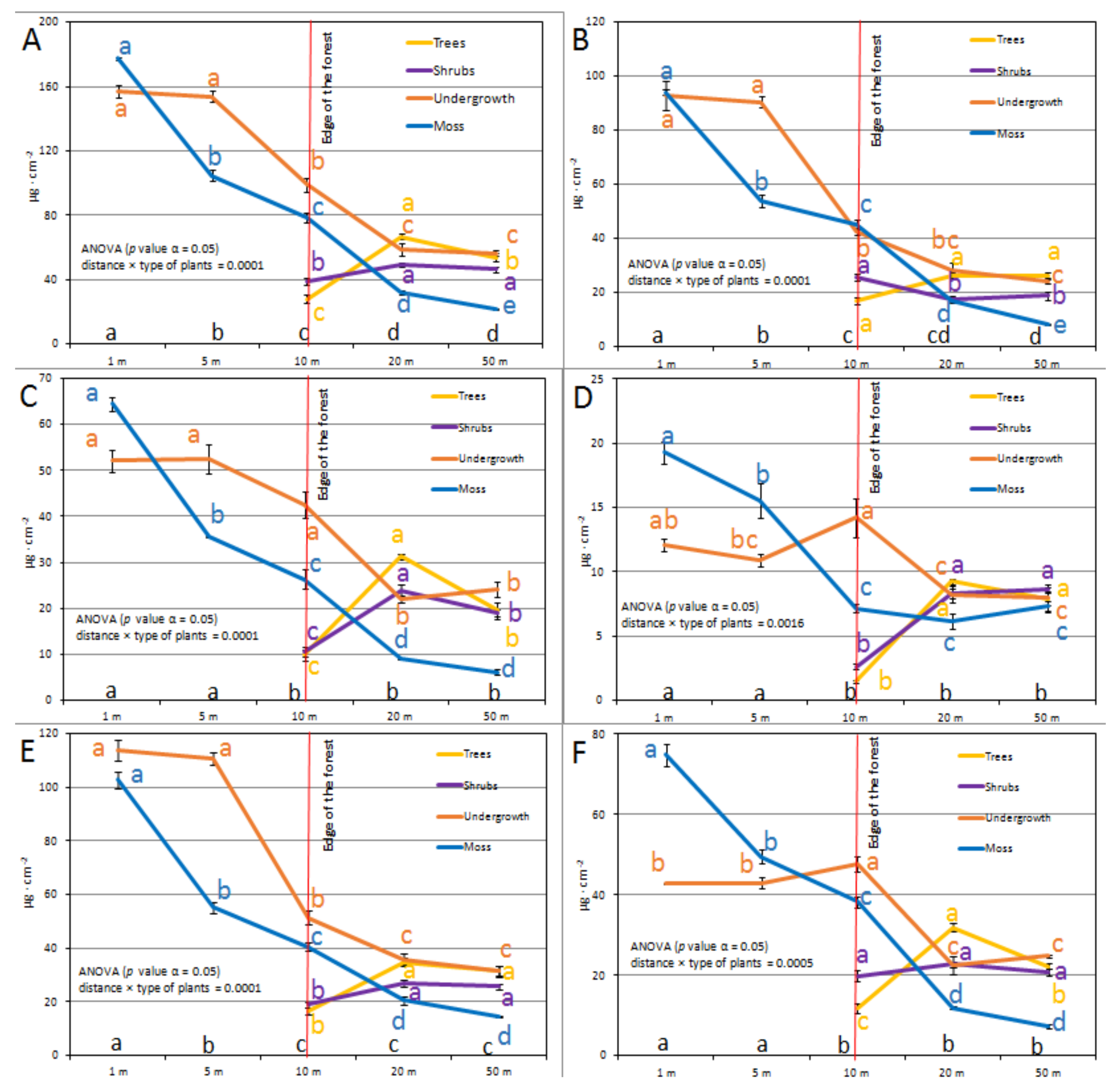
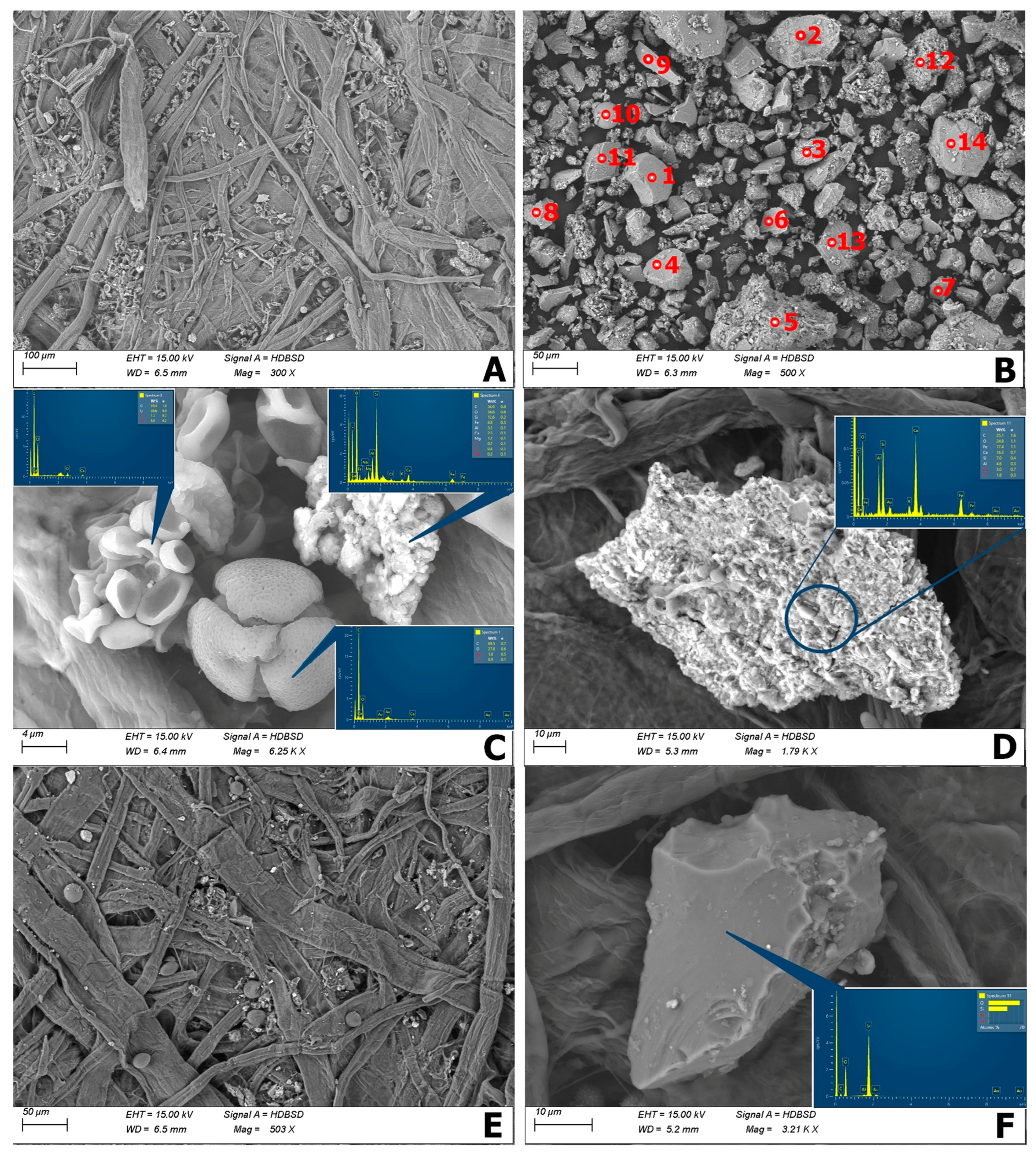

| Plant Species in Moss Layer | Cover in % | Plant Species in Herbaceous Layer | Cover in % | Plant Species in Shrub Layer | Cover in % | Plant Species in Tree Layer | Cover in % |
|---|---|---|---|---|---|---|---|
| zone 1 | |||||||
| Syntrichia ruralis | 5 | Lolium perenne | 25 | none | 0 | none | 0 |
| Plantago major | 25 | ||||||
| Poa trivialis | 15 | ||||||
| Sonchus arvensis | 10 | ||||||
| Taraxacum officinale | 10 | ||||||
| Achillea millefolium | 5 | ||||||
| Conyza canadensis | 5 | ||||||
| zone 2 | |||||||
| Syntrichia ruralis | 5 | Festuca ovina | 90 | none | 0 | none | 0 |
| Melampyrum nemerosum | 5 | ||||||
| Calamagrostis epigejos | 5 | ||||||
| Festuca rubra | 1 | ||||||
| Quercus robur | 1 | ||||||
| Linaria vulgaris | 1 | ||||||
| Hieracium pilosella | 1 | ||||||
| zone 3 | |||||||
| Pleurozium schreberi | 5 | Festuca ovina | 85 | Quercus robur | 20 | Quercus robur | 35 |
| Melampyrum nemerosum | 10 | Frangula alnus | 10 | Quercus petraea | 10 | ||
| Dactylis glomerata | 1 | Prunus padus | 5 | Frangula alnus | 5 | ||
| Calamagrostis epigejos | 1 | Cornus alba | 5 | Acer platanoides | 1 | ||
| Prunus padus | 1 | ||||||
| zone 4 | |||||||
| Pleurozium schreberi | 5 | Festuca ovina | 25 | Frangula alnus | 10 | Quercus robur | 30 |
| Calamagrostis epigejos | 15 | Quercus robur | 10 | Frangula anus | 5 | ||
| Acer platanoides | 5 | ||||||
| Frangula alnus | 5 | ||||||
| Melampyrum nemerosum | 5 | ||||||
| Acer pseudoplatanus | 1 | ||||||
| Quercus robur | 1 | ||||||
| zone 5 | |||||||
| Pleurozium schreberi | 20 | Festuca ovina | 50 | Frangula alnus | 10 | Frangula alnus | 15 |
| Frangula alnus | 10 | Prunus padus | 5 | Prunus padus | 5 | ||
| Calamagrostis epigejos | 5 | Juniperus communis | 1 | ||||
Publisher’s Note: MDPI stays neutral with regard to jurisdictional claims in published maps and institutional affiliations. |
© 2022 by the authors. Licensee MDPI, Basel, Switzerland. This article is an open access article distributed under the terms and conditions of the Creative Commons Attribution (CC BY) license (https://creativecommons.org/licenses/by/4.0/).
Share and Cite
Popek, R.; Fornal-Pieniak, B.; Chyliński, F.; Pawełkowicz, M.; Bobrowicz, J.; Chrzanowska, D.; Piechota, N.; Przybysz, A. Not Only Trees Matter—Traffic-Related PM Accumulation by Vegetation of Urban Forests. Sustainability 2022, 14, 2973. https://doi.org/10.3390/su14052973
Popek R, Fornal-Pieniak B, Chyliński F, Pawełkowicz M, Bobrowicz J, Chrzanowska D, Piechota N, Przybysz A. Not Only Trees Matter—Traffic-Related PM Accumulation by Vegetation of Urban Forests. Sustainability. 2022; 14(5):2973. https://doi.org/10.3390/su14052973
Chicago/Turabian StylePopek, Robert, Beata Fornal-Pieniak, Filip Chyliński, Magdalena Pawełkowicz, Jan Bobrowicz, Dominika Chrzanowska, Natalia Piechota, and Arkadiusz Przybysz. 2022. "Not Only Trees Matter—Traffic-Related PM Accumulation by Vegetation of Urban Forests" Sustainability 14, no. 5: 2973. https://doi.org/10.3390/su14052973
APA StylePopek, R., Fornal-Pieniak, B., Chyliński, F., Pawełkowicz, M., Bobrowicz, J., Chrzanowska, D., Piechota, N., & Przybysz, A. (2022). Not Only Trees Matter—Traffic-Related PM Accumulation by Vegetation of Urban Forests. Sustainability, 14(5), 2973. https://doi.org/10.3390/su14052973







